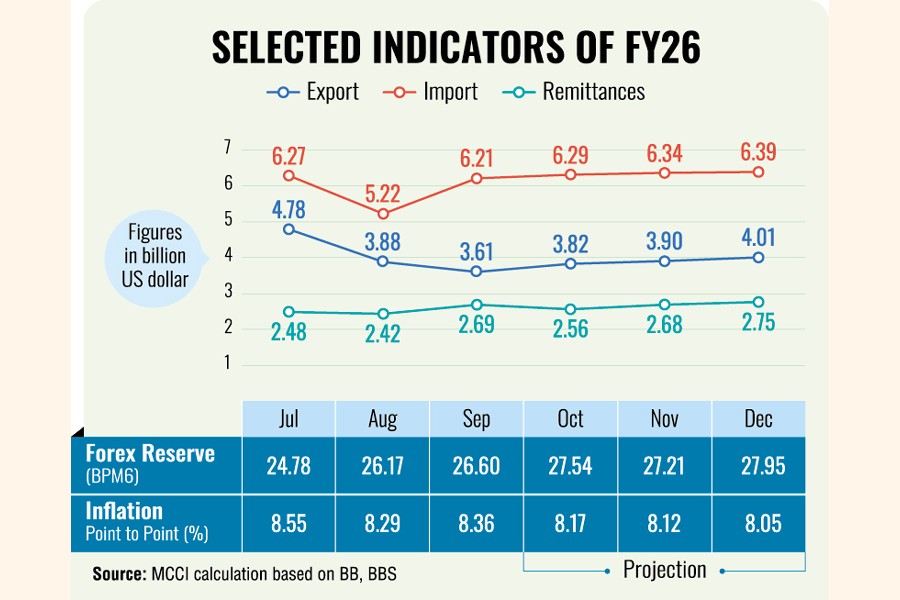
Published :
Updated :

The first quarter (Q1) of the current fiscal year shows early signs of economic recovery, though overall growth remains sluggish, the Metropolitan Chamber of Commerce and Industry, Dhaka (MCCI) has said.
"Improvements in exports, imports, inflation, and remittances have helped stabilise foreign-currency reserves and supported the broader economy," the MCCI noted in its July-September 2025 economic review released on Monday.
According to the Bangladesh Bureau of Statistics (BBS), GDP growth slowed to 3.35 per cent in the fourth quarter (Q4) of FY25, down from 4.86 per cent in the previous quarter.
The subdued environment stems from prolonged political uncertainties and the spillover effects of tight monetary and fiscal policies implemented since last year, which have significantly dampened domestic demand, the MCCI said.
"Even so, several sectors recorded year-on-year improvements during the quarter under review, supported by easing inflationary pressures and greater stability in the foreign exchange market," the trade body added.
The MCCI noted that the Bangladesh Bank's tight policy stance since August last year has further weighed on domestic demand. Private-sector credit growth fell to a historic low of 6.29 per cent in September 2025 -- far below last year's 9.20 per cent and the central bank's December 2025 target of 7.20 per cent.
Total domestic credit rose 10.20 per cent in September 2025, driven largely by increased government borrowing. Public-sector credit surged 24.45 per cent year-on-year, with net government borrowing alone rising 27.22 per cent. Despite weak private credit demand, banking-system liquidity remained ample.
The industrial sector, which accounts for over one-third of national output, continued to face strong headwinds. While Q1 FY26 data is yet to be released, Q4 FY25 figures showed industry growth slowing to 4.10 per cent from 6.91 per cent in the previous quarter.
Manufacturing-the largest industrial sub-sector and a major export driver-also weakened sharply. Growth fell to 4.64 per cent in Q4 FY25 from 7.51 per cent in Q3, while its share in GDP slipped to 23.40 per cent.
The services sector, still the largest contributor to GDP, slowed to 2.96 per cent in Q4 FY25 from 5.88 per cent in Q3, reflecting a broader demand slump.
Exports during July-September FY26 rose 5.25 per cent year-on-year to US$12.27 billion, driven by knitwear and woven garments. However, export earnings in September fell 5.10 per cent, raising concerns about winter-season orders. The sector remains exposed to weaker Western demand and evolving global sourcing trends.
Imports grew 9.49 per cent year-on-year, reflecting higher food, fuel, and raw material costs.
A strong financial account surplus of over US$1.6 billion-driven by trade credit and medium- and long-term loans-helped produce an overall balance of payments surplus of US$853 million, reversing last year's deficit.
Foreign exchange reserves improved significantly, reaching US$31.43 billion in September 2025, or US$26.60 billion under BPM6. The taka appreciated slightly by 0.79 per cent against the US dollar compared to June, reflecting improved external stability.
Remittances rose 15.95 per cent in Q1 FY26 to US$7.58 billion.
Despite these gains, inflation remained high at 8.36 per cent in September 2025, with rural households facing greater pressure. Non-food inflation also stayed elevated at 8.98 per cent due to rising transportation, education, and healthcare costs.
As Bangladesh enters Q2 FY26, policymakers face a complex challenge: reviving private investment and industrial growth without undermining progress in stabilising inflation and the foreign exchange market. The coming months will test the resilience of the recovery and the effectiveness of policy measures now in place.
tonmoy.wardad@gmail.com, siddique.islam@gmail.com


 For all latest news, follow The Financial Express Google News channel.
For all latest news, follow The Financial Express Google News channel.